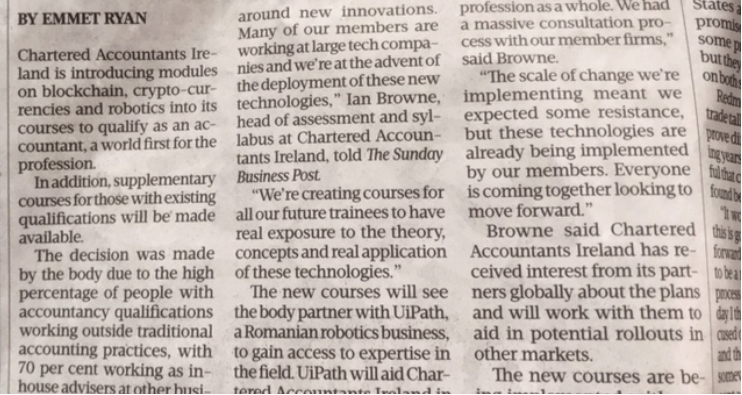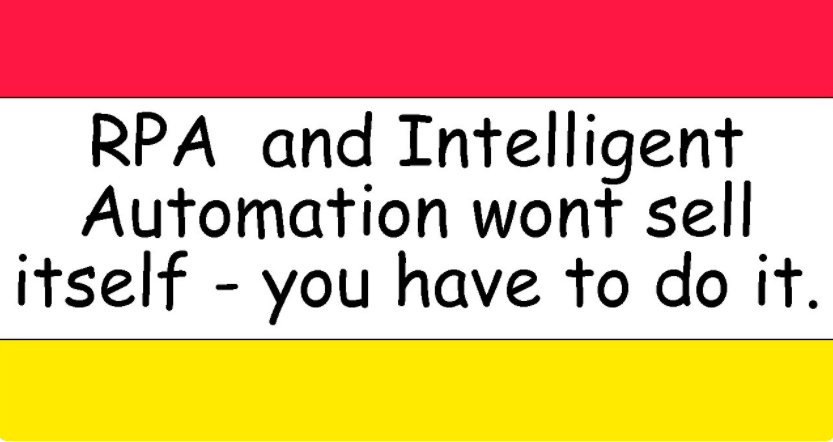C – (part 1) is for Customer Experience (CX) | Cognitive RPA | Cloud | COE | Cost | CISO |Citizen Developer | Culture | Change Mgt | Cost |
Welcome to the third in the series of 26 separate articles on the A – Z of Robotic Process Automation (RPA), Intelligent Automation (IA) and Digital Transformation (DT). Having looked at the letters A and B, today’s letter is the letter C (part 1 or 2).
This article highlights all things relating to intelligent automation and digital transformation beginning with the letter ‘C‘ (part 1 or 2).
Customer Experience (CX). Remember an organisation is there to deliver value for its customers who are willing to pay an amount in excess of cost that will result in a profitable outcome for your endeavours. Whilst new technologies, such as RPA or AI, are exciting they are simply a means to a profitable end. Always focus on the customer and the customer experience (CX) not the technology itself. Organisations that digitally transform and implement IA need to do so with the customer and the customer experience (CX) front and centre. Organisations that don’t deliver in a way that delights a customer will be replaced by one that does.
“RPA can be used to dramatically improve a customer experience. A bank automated a deposit funds transfer process which had been performed manually by a team prior to automation. When automated the process proved to be very efficient and reliable. It was then possible to include the value-add of real-time communications to the customer in relation to the status of their request. There was a notable and dramatic reduction in the volume of calls to the call-centre in both complaints and enquiries in relation to the customers’ request. This in turn eased the burden on the call-centre, and also freed up people who otherwise would have been following up on enquiries.”
Dermot Carroll, RPA Consultant
Cognitive RPA. Cognitive RPA is a phrase used to describe a combination of RPA plus AI tools to make higher level decisions (e.g. using RPA plus AI, ML, NLP, etc.). For example, by taking accepted and rejected insurance applications data and feeding them into a AI | ML model that learns how those decisions were made based; organisations are then able to use RPA to automate the acceptance or rejection of subsequent applications. This can lead to faster 24/7 decisive making and considerable cost savings for an insurance organisation.
Cloud. Clouds consumptive model enables organisations to move to an OpEx model (i.e. trade capital to operating expense). Using cloud computing, organisations can scale quickly, adding multitude of online services, to transform an organisation to a fully industrialised model within a minimal amount of time (e.g. adding machine learning to your application to personalise user experiences, driving improvements in ).
Using cloud computing, organisations are able to rapidly test new ideas such as advanced analytics or chat bots to improve customer (CX), staff (EX) and user experiences (UX) without the need for large upfront investments in hardware or development resource. Using cloud computing, organisations can grow or shrink capacity as organisational needs change.
To scale at pace, RPA | IA programs organisations need to build on a cloud platform to enable your organisation to scale to multiple locations or countries in a matter of click. However, not all RPA | IA products, or ecosystem partners, are cloud ready. Check if your RPA | IA platform and ecosystem of vendor tools are cloud ready before you buy into a vendors ecosystem.
Seek reference sites and have conversations with your vendors cloud architect to satisfy your organisation that the RPA | IA platform your organisation is investing in is cloud ready and secure. Expert RPA | IA cloud architects are the elusive ‘golden geese’ of RPA. Excellent, multi-year experienced RPA | IA cloud architects are few in number. Do mark the strength of sample clients, client satisfaction, and industry references of RPA | IA product users in your business area.
“The future is cloud. Do you really want to buy the past? Isn’t that what got us in this mess in the first place?”
Edward Halsey, RPA Enterprise Account Manager
Centre of Expertise. If your organisation wishes to scale at any level then you will need a COE. An RPA | IA CoE is a collective pool of capabilities that organisations require to to drive all the functionalities of an RPA | IA initiative.
Setting up a COE is a crucial step in moving from a proof of concept stage to distributing and scaling RPA | IA across your organisation.
“A good CoE is essential, every organisation is different. Not only will the CoE develop your best practices across the full spectrum of RPA activities. The CoE should be responsible for communicating these best practices to the various RPA teams within the organisation regardless of their geographical location. A CoE should also be the central point of contact for all RPA aspects, and should also be promoting consistent messages to internal, external and cross-functional teams.”
Dermot Carroll, RPA Consultant
A COE team should develop best practices; engage with IT to provide a stable cloud computing environment; set strategy; provide additional capacity and capabilities; have the business and technical skills are required to succeed; ensure business cases stack up; setup and run governance programs; review risk and plan mitigations for your IA program; promote the RPA | IA vision; help setup RPA | IA hubs within business functions; promote training and support for developers; have design thinking and lean for digital skills; monitor environments; maintain existing automation; introduce and distribute best practices; lead RPA | IA innovation efforts; communicate to wins hearts and minds; and lots more besides.
‘Building a cross functional and cross skilled team is an extremely important aspect of any digital transformation. You need to ensure you have the right business knowledge and technical knowledge for your company to succeed.’
Matthew Coffey, RPA Delivery Lead at Pearson
Cost. RPA is not cheap to implement and run. Be willing to invest considerable time, money and energy over many years to deliver a digital transformation program. Tool selection can take up to 4 months; a pilot should take 8-12 weeks and cost around between £20k and £50k; the first 6 months of an RPA program will most likely cost you between £120 and £250k (think licences; system integrator and consulting help; recruitment cost of an RPA lead/team; cloud installation costs; RPA process analyst; purchase cost of process mining software; etc.) and an end to end and a fully-fledged RPA program with a business case built out over 3 to 5 business years will cost your multiples of that first 6 month cost.
Be conservative in your estimates for cost savings from RPA effort, especially if you have never previously automated a process, application or set of applications before. RPA implementations require more effort and ongoing support than originally estimated. Vendors often quote programs paying back after 6-9 months but this is often not the case in larger enterprises where it can take months to simply get a program up and running. RPA, done right, is neither cheap nor fast. It can be inexpensive and faster than other methods, but RPA isn’t free!
“Once you’ve chosen a product, and significantly invested in building your automation journey on top of it, then you are likely locked-in or face large costs to migrate, as currently there is no easy way to port between vendors. Choose wisely!”
Paul Arnold, Head of Product and Development at Cortex Intelligent Automation
CISO. We live in a digital age where data security is key. Just because a robot or AI is undertaking a task or making a decision does not mean that digital fundamentals can be forgotten. An RPA | IA black box needs to be understood, made secure by design and securely managed. Protecting customer’s data and consequently an organisation’s reputation is a critical component of running a digital business.
Application security; credential management; risk and security assessments; segregation of duties; delivering security by design; data encryption and security; as well as process and data tractability are more key than ever. We live in an age where an organisations Chief Information Security Officer is needed more than ever so as to guarantee that organisations are protected and on the right side of the law.
Culture. An organisation must be ready for RPA | IA. A workforce culture that truly embraces change will provide a platform for you to succeed at anything. A siloed, broken culture, riven by personal interest will stop any program, technology or otherwise, in its tracks. Which is yours?
‘I’ve been banging the drum about this one for years. An RPA programme will only succeed when both IT and Business Operations form a collaborative partnership to deliver the capability. I should know, I have implemented RPA from an IT, Business Operations and Consultancy perspective, and had to deal with the aftermath of IT feeling like the technology has been implemented ‘side of desk’ or forced upon them. Form a trusted partnership rather than having to fix broken relationships further down the line ‘
Allan Surtees, Head of Intelligent Process Automation at Lowell Financial
Citizen Developers. If RPA | IA programs are to scale then everyone needs to suggest and automate processes. Citizen developers – getting RPA into the hands of the business is key to RPA becoming another tool in the ordinary business users toolkit – just as folks use excel, word, a calculator – their ability to automate should become de-rigour too. RPA is not rocket science and with the right guidance, support, training and code governance your business users can develop at pace.
“While RPA itself may not be rocket science, arguably the approach to the business project that is RPA is! That said carefully selecting business team members to join the RPA journey does work well. It’s true that they may not need a technical or development background, but woe-betide you if you don’t support, mentor and coach these people with experienced RPA people who do have significant projects delivery experience.”
Dermot Carroll, RPA Consultant
However, RPA is not easy either and a comprehensive training and support program needs to be developed to provide staff with the right skills and support needed to sustain a citizen lead transformation program.
“Scaling RPA is a common challenge across the industry but my experience is a lot more fundamental than that. Organisations are often being sold the concept of RPA as a business tool for business users and whilst I fully support the democratisation of RPA, many business users struggle to automate anything but the most simple of processes. This has a significant impact on their ability to scale RPA to enough processes to make a dent, but can also result in a negative experience across the business, inevitably leading to organisations collapsing their investment in RPA or retaining it for a very small niche of processes.
Our experience has been that by enlisting the help of experienced delivery organisations for anything more complex, their RPA implementations scale much farther and wider, helping them to realise return on their investment and improve the overall sentiment of RPA internally.”
Amyn Jaffer – Head of Intelligent Automation at Ultima.
RPA | IA programs are not a silver bullet for digital transformation, but they can be powerful automation tools when employed in combination over the long term.
What C’s do you consider to be the most important for an RPA | IA program?
If you like this article then you may find these useful too.
- C – (part 2) is for Customer | Cognitive RPA | Centre of Expertise | Cost | CISO | Citizen Developer(s) | Culture | Customer Experience (CX) |
- 8 questions to ask before you implement RPA.
- 14 rules for Robotic Process Automation (RPA) and Intelligent Automation (AI) success
- Behaviours of an Agile Developer
- Behavioural traits of an Agile Developer
- If you are not willing to go all in, then don’t put on your RPA swimsuit.
- The biggest lie told to RPA customers – 50 robots equals success
- 40 essential selection criteria to choose an RPA platform
- The A-Z of RPA, AI and Digital Transformation
- 9 Key Roles in your Robotic Process Automation Centre of Expertise
Free to share! If you think this article would be beneficial to others please feel free to share it. If you want to post this article on your LinkedIn page then please feel free to do so. The more information we share within the RPA community the more likely businesses are to succeed with this excellent technology.
Further Help: If I can help you in any way please do reach out.
Note: The views expressed above are my views and the views of the contributors. They are not those of my employer or the contributors employers.







Leave a Reply